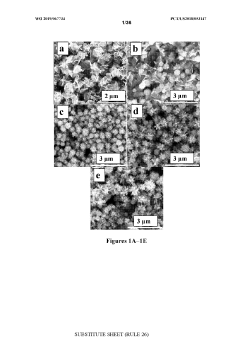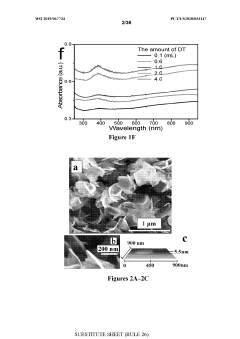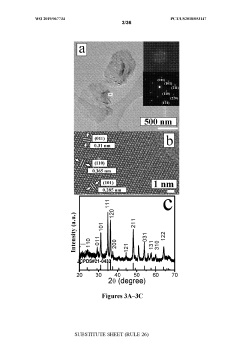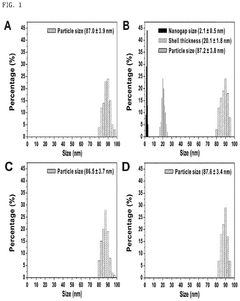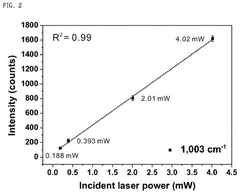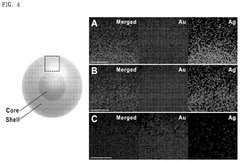Role of Geometric Isomers in Engineered Nanoparticle Agglomeration
AUG 1, 20259 MIN READ
Generate Your Research Report Instantly with AI Agent
Patsnap Eureka helps you evaluate technical feasibility & market potential.
Nanoparticle Isomerism and Agglomeration Objectives
The field of engineered nanoparticles has witnessed significant advancements in recent years, with a growing focus on understanding the role of geometric isomers in nanoparticle agglomeration. This research area aims to elucidate the complex relationships between nanoparticle structure, isomerism, and their tendency to form larger aggregates. The primary objective is to develop a comprehensive understanding of how different geometric configurations of nanoparticles influence their agglomeration behavior in various environments.
One key goal is to investigate the impact of structural isomerism on the surface properties of nanoparticles, including charge distribution, reactivity, and interfacial interactions. By examining these factors, researchers seek to predict and control agglomeration processes more effectively, leading to improved stability and performance of nanoparticle-based systems.
Another critical objective is to explore the role of geometric isomers in modulating the kinetics and thermodynamics of nanoparticle agglomeration. This includes studying how different isomeric forms affect the rate of aggregate formation, the size and morphology of resulting clusters, and the overall stability of nanoparticle dispersions.
Furthermore, the research aims to develop novel characterization techniques and computational models to accurately assess and predict the behavior of geometric isomers in complex nanoparticle systems. These tools will enable more precise control over nanoparticle properties and their interactions in various applications, from drug delivery to environmental remediation.
An additional objective is to investigate the potential for leveraging geometric isomerism to create "smart" nanoparticle systems that can respond to external stimuli by altering their agglomeration state. This could lead to the development of advanced materials with switchable properties, opening up new possibilities in fields such as sensing, catalysis, and responsive coatings.
Lastly, the research seeks to establish guidelines and best practices for designing nanoparticles with specific geometric isomers to achieve desired agglomeration behaviors. This knowledge will be crucial for optimizing nanoparticle performance in diverse applications, ranging from biomedical imaging to energy storage technologies.
One key goal is to investigate the impact of structural isomerism on the surface properties of nanoparticles, including charge distribution, reactivity, and interfacial interactions. By examining these factors, researchers seek to predict and control agglomeration processes more effectively, leading to improved stability and performance of nanoparticle-based systems.
Another critical objective is to explore the role of geometric isomers in modulating the kinetics and thermodynamics of nanoparticle agglomeration. This includes studying how different isomeric forms affect the rate of aggregate formation, the size and morphology of resulting clusters, and the overall stability of nanoparticle dispersions.
Furthermore, the research aims to develop novel characterization techniques and computational models to accurately assess and predict the behavior of geometric isomers in complex nanoparticle systems. These tools will enable more precise control over nanoparticle properties and their interactions in various applications, from drug delivery to environmental remediation.
An additional objective is to investigate the potential for leveraging geometric isomerism to create "smart" nanoparticle systems that can respond to external stimuli by altering their agglomeration state. This could lead to the development of advanced materials with switchable properties, opening up new possibilities in fields such as sensing, catalysis, and responsive coatings.
Lastly, the research seeks to establish guidelines and best practices for designing nanoparticles with specific geometric isomers to achieve desired agglomeration behaviors. This knowledge will be crucial for optimizing nanoparticle performance in diverse applications, ranging from biomedical imaging to energy storage technologies.
Market Demand for Controlled Nanoparticle Agglomeration
The market demand for controlled nanoparticle agglomeration, particularly in the context of geometric isomers, has been steadily growing across various industries. This demand is primarily driven by the increasing recognition of the critical role that nanoparticle agglomeration plays in determining the properties and performance of nanomaterials in diverse applications.
In the pharmaceutical industry, there is a significant interest in controlling nanoparticle agglomeration to enhance drug delivery systems. The ability to manipulate geometric isomers in engineered nanoparticles allows for more precise targeting and improved bioavailability of therapeutic agents. This has led to a surge in research and development activities focused on optimizing nanoparticle formulations for drug delivery applications.
The electronics sector has also shown a growing demand for controlled nanoparticle agglomeration. As miniaturization continues to be a driving force in the industry, the need for precise control over nanoparticle assembly becomes crucial. Geometric isomers play a vital role in determining the electrical and optical properties of nanoparticle-based devices, making their controlled agglomeration essential for developing next-generation electronic components and sensors.
Environmental remediation is another area where the demand for controlled nanoparticle agglomeration is on the rise. The unique properties of engineered nanoparticles, when properly controlled, can be harnessed for efficient removal of pollutants from water and soil. The ability to manipulate geometric isomers in these nanoparticles allows for the development of more effective and selective remediation technologies.
In the energy sector, particularly in the development of advanced energy storage systems and catalysts, there is a growing recognition of the importance of controlled nanoparticle agglomeration. The arrangement of geometric isomers in nanoparticle assemblies can significantly impact the performance of batteries, fuel cells, and photovoltaic devices. This has led to increased investment in research aimed at optimizing nanoparticle structures for enhanced energy conversion and storage efficiency.
The materials science industry has also seen a surge in demand for controlled nanoparticle agglomeration techniques. The ability to manipulate geometric isomers allows for the creation of novel materials with tailored properties, such as enhanced strength, improved thermal conductivity, or unique optical characteristics. This has opened up new possibilities in the development of advanced composites, coatings, and functional materials.
As the potential applications of controlled nanoparticle agglomeration continue to expand, the market demand is expected to grow further. Industries are increasingly recognizing the value of precise control over nanoparticle assembly in driving innovation and improving product performance. This trend is likely to fuel ongoing research and development efforts, as well as investments in technologies that enable better manipulation and characterization of geometric isomers in engineered nanoparticles.
In the pharmaceutical industry, there is a significant interest in controlling nanoparticle agglomeration to enhance drug delivery systems. The ability to manipulate geometric isomers in engineered nanoparticles allows for more precise targeting and improved bioavailability of therapeutic agents. This has led to a surge in research and development activities focused on optimizing nanoparticle formulations for drug delivery applications.
The electronics sector has also shown a growing demand for controlled nanoparticle agglomeration. As miniaturization continues to be a driving force in the industry, the need for precise control over nanoparticle assembly becomes crucial. Geometric isomers play a vital role in determining the electrical and optical properties of nanoparticle-based devices, making their controlled agglomeration essential for developing next-generation electronic components and sensors.
Environmental remediation is another area where the demand for controlled nanoparticle agglomeration is on the rise. The unique properties of engineered nanoparticles, when properly controlled, can be harnessed for efficient removal of pollutants from water and soil. The ability to manipulate geometric isomers in these nanoparticles allows for the development of more effective and selective remediation technologies.
In the energy sector, particularly in the development of advanced energy storage systems and catalysts, there is a growing recognition of the importance of controlled nanoparticle agglomeration. The arrangement of geometric isomers in nanoparticle assemblies can significantly impact the performance of batteries, fuel cells, and photovoltaic devices. This has led to increased investment in research aimed at optimizing nanoparticle structures for enhanced energy conversion and storage efficiency.
The materials science industry has also seen a surge in demand for controlled nanoparticle agglomeration techniques. The ability to manipulate geometric isomers allows for the creation of novel materials with tailored properties, such as enhanced strength, improved thermal conductivity, or unique optical characteristics. This has opened up new possibilities in the development of advanced composites, coatings, and functional materials.
As the potential applications of controlled nanoparticle agglomeration continue to expand, the market demand is expected to grow further. Industries are increasingly recognizing the value of precise control over nanoparticle assembly in driving innovation and improving product performance. This trend is likely to fuel ongoing research and development efforts, as well as investments in technologies that enable better manipulation and characterization of geometric isomers in engineered nanoparticles.
Current Challenges in Geometric Isomer-Induced Agglomeration
The current challenges in geometric isomer-induced agglomeration of engineered nanoparticles present a complex landscape of scientific and technical hurdles. One of the primary difficulties lies in the precise control and manipulation of geometric isomers at the nanoscale. The spatial arrangement of atoms in these isomers can significantly influence their interactions, leading to unpredictable agglomeration behaviors that are difficult to model and predict accurately.
A major challenge is the lack of standardized methodologies for characterizing and quantifying the impact of geometric isomers on nanoparticle agglomeration. This absence of uniform protocols hampers the comparison of results across different studies and impedes the development of a comprehensive understanding of the phenomenon. Researchers struggle to isolate the effects of geometric isomerism from other factors that influence agglomeration, such as surface chemistry, particle size, and environmental conditions.
The dynamic nature of nanoparticle systems further complicates the study of geometric isomer-induced agglomeration. Nanoparticles can undergo rapid transformations in response to their environment, potentially altering their geometric configuration and agglomeration properties. This temporal instability makes it challenging to capture and analyze the agglomeration process in real-time, necessitating the development of advanced in situ characterization techniques.
Another significant challenge is the scalability of production processes that can maintain control over geometric isomerism. While laboratory-scale synthesis may achieve a high degree of control, translating these methods to industrial-scale production while preserving the desired geometric properties remains a formidable task. This scaling issue limits the practical application of engineered nanoparticles with specific geometric isomer configurations in various fields.
The interdisciplinary nature of this research area also poses challenges. It requires expertise from diverse fields such as materials science, physical chemistry, colloidal science, and computational modeling. Bridging the knowledge gaps between these disciplines and fostering effective collaboration is essential for addressing the complex issues surrounding geometric isomer-induced agglomeration.
Furthermore, the environmental and health implications of geometric isomer-induced agglomeration are not yet fully understood. There is a pressing need for comprehensive toxicological studies to assess the potential risks associated with different geometric configurations and their agglomeration products. This knowledge gap hinders the development of safety guidelines and regulatory frameworks for the responsible use of engineered nanoparticles.
Lastly, the development of theoretical models that can accurately predict the agglomeration behavior of nanoparticles based on their geometric isomerism remains a significant challenge. Current models often fail to capture the full complexity of the interactions involved, limiting their predictive power and applicability in real-world scenarios. Overcoming this challenge requires advancements in computational methods and a deeper understanding of the fundamental physics governing nanoparticle interactions.
A major challenge is the lack of standardized methodologies for characterizing and quantifying the impact of geometric isomers on nanoparticle agglomeration. This absence of uniform protocols hampers the comparison of results across different studies and impedes the development of a comprehensive understanding of the phenomenon. Researchers struggle to isolate the effects of geometric isomerism from other factors that influence agglomeration, such as surface chemistry, particle size, and environmental conditions.
The dynamic nature of nanoparticle systems further complicates the study of geometric isomer-induced agglomeration. Nanoparticles can undergo rapid transformations in response to their environment, potentially altering their geometric configuration and agglomeration properties. This temporal instability makes it challenging to capture and analyze the agglomeration process in real-time, necessitating the development of advanced in situ characterization techniques.
Another significant challenge is the scalability of production processes that can maintain control over geometric isomerism. While laboratory-scale synthesis may achieve a high degree of control, translating these methods to industrial-scale production while preserving the desired geometric properties remains a formidable task. This scaling issue limits the practical application of engineered nanoparticles with specific geometric isomer configurations in various fields.
The interdisciplinary nature of this research area also poses challenges. It requires expertise from diverse fields such as materials science, physical chemistry, colloidal science, and computational modeling. Bridging the knowledge gaps between these disciplines and fostering effective collaboration is essential for addressing the complex issues surrounding geometric isomer-induced agglomeration.
Furthermore, the environmental and health implications of geometric isomer-induced agglomeration are not yet fully understood. There is a pressing need for comprehensive toxicological studies to assess the potential risks associated with different geometric configurations and their agglomeration products. This knowledge gap hinders the development of safety guidelines and regulatory frameworks for the responsible use of engineered nanoparticles.
Lastly, the development of theoretical models that can accurately predict the agglomeration behavior of nanoparticles based on their geometric isomerism remains a significant challenge. Current models often fail to capture the full complexity of the interactions involved, limiting their predictive power and applicability in real-world scenarios. Overcoming this challenge requires advancements in computational methods and a deeper understanding of the fundamental physics governing nanoparticle interactions.
Existing Strategies for Isomer-Mediated Agglomeration
01 Synthesis and characterization of geometric isomers of nanoparticles
Methods for synthesizing and characterizing geometric isomers of engineered nanoparticles, including techniques for controlling shape and size during synthesis. This involves advanced analytical methods to distinguish between different isomeric forms and their properties.- Synthesis and characterization of geometric isomers of nanoparticles: Methods for synthesizing and characterizing geometric isomers of engineered nanoparticles, including techniques for controlling shape and size during synthesis. This involves advanced analytical methods to identify and differentiate between various geometric configurations of nanoparticles.
- Agglomeration behavior of nanoparticle geometric isomers: Studies on how different geometric isomers of nanoparticles tend to agglomerate, including factors affecting agglomeration such as surface properties, environmental conditions, and inter-particle interactions. This research aims to understand and predict agglomeration patterns for various nanoparticle shapes.
- Impact of geometric isomers on nanoparticle applications: Investigation of how the geometric isomerism of nanoparticles affects their performance in various applications, such as drug delivery, catalysis, and materials science. This includes studying how different shapes influence properties like reactivity, stability, and functionality.
- Modeling and simulation of nanoparticle geometric isomers: Development of computational models and simulation techniques to predict and analyze the behavior of geometric isomers of nanoparticles, including their agglomeration tendencies. These models help in understanding complex interactions and properties at the nanoscale.
- Separation and purification of nanoparticle geometric isomers: Techniques for separating and purifying different geometric isomers of nanoparticles, including methods to isolate specific shapes or configurations. This is crucial for obtaining uniform nanoparticle populations for research and applications, and for studying the properties of individual isomers.
02 Agglomeration behavior of nanoparticle geometric isomers
Studies on the agglomeration tendencies of different geometric isomers of nanoparticles, examining how shape and surface properties influence their clustering behavior in various media. This includes investigations into the stability and dispersion characteristics of isomeric nanoparticles.Expand Specific Solutions03 Impact of geometric isomerism on nanoparticle applications
Exploration of how the geometric isomerism of nanoparticles affects their performance in various applications, such as drug delivery, catalysis, and materials science. This includes studies on how different isomeric forms interact with biological systems or influence chemical reactions.Expand Specific Solutions04 Modeling and simulation of nanoparticle isomer agglomeration
Development of computational models and simulation techniques to predict and understand the agglomeration behavior of geometric isomers of nanoparticles. This includes molecular dynamics simulations and theoretical approaches to study isomer-specific interactions.Expand Specific Solutions05 Control and prevention of nanoparticle isomer agglomeration
Strategies and methods to control or prevent the agglomeration of geometric isomers of nanoparticles, including surface modifications, stabilizing agents, and environmental condition adjustments. This research aims to maintain the desired properties and performance of isomeric nanoparticles in various applications.Expand Specific Solutions
Key Players in Engineered Nanoparticle Industry
The field of geometric isomers in engineered nanoparticle agglomeration is in an early developmental stage, with significant potential for growth. The market size is expanding as nanotechnology applications increase across industries. While the technology is still maturing, several key players are advancing research and development. Organizations like Centre National de la Recherche Scientifique, Rensselaer Polytechnic Institute, and Oregon Health & Science University are leading academic efforts. Companies such as Arkema France SA, Merck Patent GmbH, and Spago Nanomedical AB are driving commercial applications. Collaboration between academia and industry is crucial for accelerating progress in this emerging field.
Centre National de la Recherche Scientifique
Technical Solution: CNRS has developed a comprehensive approach to studying geometric isomers in nanoparticle agglomeration. Their research focuses on the impact of different isomeric configurations on the self-assembly and aggregation behavior of engineered nanoparticles. They utilize advanced characterization techniques such as dynamic light scattering and atomic force microscopy to analyze the formation and stability of nanoparticle clusters[1]. CNRS researchers have also investigated the role of surface chemistry and environmental conditions in modulating isomer-dependent agglomeration processes. Their findings suggest that geometric isomers can significantly influence the kinetics and thermodynamics of nanoparticle aggregation, with implications for the design of stable colloidal systems and the prediction of nanoparticle fate in complex environments[3].
Strengths: Comprehensive research approach, advanced characterization techniques, and focus on fundamental mechanisms. Weaknesses: May lack immediate industrial applications, and research might be more theoretical than practical for some sectors.
Merck Patent GmbH
Technical Solution: Merck Patent GmbH has developed innovative strategies to control nanoparticle agglomeration by exploiting geometric isomerism. Their approach involves designing nanoparticles with specific isomeric surface ligands that can be switched between different conformations using external stimuli such as light or pH changes[2]. This allows for dynamic control over particle-particle interactions and agglomeration behavior. Merck's research has shown that by carefully selecting geometric isomers, they can create "smart" nanoparticle systems that can reversibly aggregate or disperse on demand. This technology has potential applications in drug delivery, where controlled agglomeration can be used to modulate drug release profiles or target specific tissues[4]. Additionally, Merck has explored the use of geometric isomers in creating self-healing nanocomposite materials, where controlled agglomeration can be used to repair damage and restore material properties[5].
Strengths: Dynamic control over nanoparticle interactions, potential for smart and responsive materials, applications in drug delivery. Weaknesses: Complexity of implementation in large-scale manufacturing, potential regulatory challenges for biomedical applications.
Core Innovations in Geometric Isomer Manipulation
Self-assembly methods for forming hedgehog-shaped particles
PatentWO2019067734A1
Innovation
- A self-assembly method combining metal-containing and chalcogen-containing precursors with specific additives, such as dodecanethiol and oleylamine, to form hedgehog-shaped particles with a core region and orthogonal spikes, where the precursors are heated to facilitate the formation of single-crystal nanosheets that roll into needles, creating particles with unique geometries and properties.
Plasmonic nanoparticles with intra-nanogap produced by dealloying, method for preparing the same and use thereof
PatentActiveUS12109620B2
Innovation
- A method for preparing core-gap-shell nanoparticles with a hollow nanogap using selective-interdiffusive dealloying (SID), where a shell made of an alloy of two metals is introduced onto a core particle modified with a Raman-active material, and the second metal is selectively removed using an etchant, creating a nanogap without an interlayer, allowing for the deposition of a Raman-active material within the gap.
Environmental Impact of Nanoparticle Agglomerates
The environmental impact of nanoparticle agglomerates is a critical concern as engineered nanoparticles become increasingly prevalent in various industries and consumer products. The agglomeration of nanoparticles, influenced by geometric isomers, can significantly alter their behavior and interactions with the environment.
Nanoparticle agglomerates can have both positive and negative effects on ecosystems. In some cases, agglomeration may reduce the bioavailability and toxicity of nanoparticles, potentially mitigating their harmful effects on organisms. However, this process can also lead to the formation of larger particles that may settle more quickly in aquatic environments, affecting sediment-dwelling organisms.
The role of geometric isomers in nanoparticle agglomeration can influence the environmental fate and transport of these materials. Different isomeric forms may result in varying degrees of agglomeration, affecting the particles' mobility in air, water, and soil. This, in turn, impacts their distribution and potential exposure routes for organisms.
Agglomerated nanoparticles may exhibit altered surface properties, potentially affecting their ability to adsorb pollutants or interact with biological membranes. This can have implications for the bioaccumulation and biomagnification of nanoparticles in food chains, as well as their potential to act as carriers for other contaminants.
The persistence of nanoparticle agglomerates in the environment is another crucial factor to consider. Depending on their composition and the influence of geometric isomers, these agglomerates may be more or less resistant to degradation processes. This can lead to long-term accumulation in certain environmental compartments, potentially causing chronic exposure to ecosystems.
Atmospheric transport and deposition of nanoparticle agglomerates can impact air quality and contribute to the long-range transport of these materials. The size and shape of agglomerates, influenced by geometric isomers, can affect their aerodynamic properties and, consequently, their atmospheric residence time and deposition patterns.
In aquatic systems, the sedimentation of nanoparticle agglomerates can alter benthic habitats and affect the organisms living in or near the sediment. The potential for these agglomerates to release individual nanoparticles over time may lead to prolonged exposure for aquatic organisms.
Understanding the environmental impact of nanoparticle agglomerates requires consideration of their potential to interact with natural organic matter and other environmental constituents. These interactions can further modify the behavior and toxicity of the agglomerates, highlighting the complexity of predicting their environmental fate and effects.
Nanoparticle agglomerates can have both positive and negative effects on ecosystems. In some cases, agglomeration may reduce the bioavailability and toxicity of nanoparticles, potentially mitigating their harmful effects on organisms. However, this process can also lead to the formation of larger particles that may settle more quickly in aquatic environments, affecting sediment-dwelling organisms.
The role of geometric isomers in nanoparticle agglomeration can influence the environmental fate and transport of these materials. Different isomeric forms may result in varying degrees of agglomeration, affecting the particles' mobility in air, water, and soil. This, in turn, impacts their distribution and potential exposure routes for organisms.
Agglomerated nanoparticles may exhibit altered surface properties, potentially affecting their ability to adsorb pollutants or interact with biological membranes. This can have implications for the bioaccumulation and biomagnification of nanoparticles in food chains, as well as their potential to act as carriers for other contaminants.
The persistence of nanoparticle agglomerates in the environment is another crucial factor to consider. Depending on their composition and the influence of geometric isomers, these agglomerates may be more or less resistant to degradation processes. This can lead to long-term accumulation in certain environmental compartments, potentially causing chronic exposure to ecosystems.
Atmospheric transport and deposition of nanoparticle agglomerates can impact air quality and contribute to the long-range transport of these materials. The size and shape of agglomerates, influenced by geometric isomers, can affect their aerodynamic properties and, consequently, their atmospheric residence time and deposition patterns.
In aquatic systems, the sedimentation of nanoparticle agglomerates can alter benthic habitats and affect the organisms living in or near the sediment. The potential for these agglomerates to release individual nanoparticles over time may lead to prolonged exposure for aquatic organisms.
Understanding the environmental impact of nanoparticle agglomerates requires consideration of their potential to interact with natural organic matter and other environmental constituents. These interactions can further modify the behavior and toxicity of the agglomerates, highlighting the complexity of predicting their environmental fate and effects.
Safety Regulations for Engineered Nanoparticles
The safety regulations for engineered nanoparticles have become increasingly important as the field of nanotechnology continues to advance. These regulations aim to protect human health and the environment from potential risks associated with the production, use, and disposal of engineered nanoparticles, including those involving geometric isomers.
Regulatory bodies worldwide have recognized the unique properties of nanoparticles and the need for specific guidelines to address their potential hazards. The European Union, for instance, has implemented the REACH (Registration, Evaluation, Authorization, and Restriction of Chemicals) regulation, which includes provisions for nanomaterials. This framework requires manufacturers and importers to register nanoparticles and provide safety data before they can be placed on the market.
In the United States, the Environmental Protection Agency (EPA) has developed a comprehensive approach to regulating nanomaterials under the Toxic Substances Control Act (TSCA). This includes mandatory reporting and recordkeeping requirements for companies that manufacture or process nanoscale materials. The EPA also conducts case-by-case reviews of new nanoscale materials to assess their potential risks.
The Occupational Safety and Health Administration (OSHA) in the US has issued guidelines for working with nanomaterials in laboratories and industrial settings. These guidelines emphasize the importance of engineering controls, personal protective equipment, and proper handling procedures to minimize worker exposure to potentially harmful nanoparticles.
International organizations, such as the Organization for Economic Co-operation and Development (OECD), have developed standardized testing methods and risk assessment frameworks specifically for nanomaterials. These efforts aim to harmonize global approaches to nanoparticle safety and facilitate the exchange of scientific data between countries.
As research on geometric isomers in engineered nanoparticle agglomeration continues to evolve, regulatory bodies are adapting their guidelines to address this specific aspect of nanoparticle behavior. The potential for different geometric isomers to influence agglomeration patterns and, consequently, the toxicity and environmental fate of nanoparticles is being incorporated into risk assessment protocols.
Manufacturers and researchers working with engineered nanoparticles are required to consider the role of geometric isomers in their safety evaluations. This includes assessing how different isomeric forms may affect the tendency of nanoparticles to agglomerate, their interactions with biological systems, and their potential for environmental persistence or degradation.
Regulatory bodies worldwide have recognized the unique properties of nanoparticles and the need for specific guidelines to address their potential hazards. The European Union, for instance, has implemented the REACH (Registration, Evaluation, Authorization, and Restriction of Chemicals) regulation, which includes provisions for nanomaterials. This framework requires manufacturers and importers to register nanoparticles and provide safety data before they can be placed on the market.
In the United States, the Environmental Protection Agency (EPA) has developed a comprehensive approach to regulating nanomaterials under the Toxic Substances Control Act (TSCA). This includes mandatory reporting and recordkeeping requirements for companies that manufacture or process nanoscale materials. The EPA also conducts case-by-case reviews of new nanoscale materials to assess their potential risks.
The Occupational Safety and Health Administration (OSHA) in the US has issued guidelines for working with nanomaterials in laboratories and industrial settings. These guidelines emphasize the importance of engineering controls, personal protective equipment, and proper handling procedures to minimize worker exposure to potentially harmful nanoparticles.
International organizations, such as the Organization for Economic Co-operation and Development (OECD), have developed standardized testing methods and risk assessment frameworks specifically for nanomaterials. These efforts aim to harmonize global approaches to nanoparticle safety and facilitate the exchange of scientific data between countries.
As research on geometric isomers in engineered nanoparticle agglomeration continues to evolve, regulatory bodies are adapting their guidelines to address this specific aspect of nanoparticle behavior. The potential for different geometric isomers to influence agglomeration patterns and, consequently, the toxicity and environmental fate of nanoparticles is being incorporated into risk assessment protocols.
Manufacturers and researchers working with engineered nanoparticles are required to consider the role of geometric isomers in their safety evaluations. This includes assessing how different isomeric forms may affect the tendency of nanoparticles to agglomerate, their interactions with biological systems, and their potential for environmental persistence or degradation.
Unlock deeper insights with Patsnap Eureka Quick Research — get a full tech report to explore trends and direct your research. Try now!
Generate Your Research Report Instantly with AI Agent
Supercharge your innovation with Patsnap Eureka AI Agent Platform!
